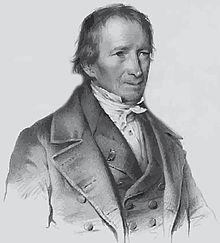Johann Nepomuk von Fuchs (15 May 1774 – 5 March 1856)[1] was a German chemist and mineralogist, and royal Bavarian privy councillor.
Biography
He was born at Mattenzell, near Falkenstein in the Bavarian Forest. In 1807 he became professor of chemistry and mineralogy at the Ludwig Maximilian University, which was located in Landshut at the time, and in 1823 conservator of the mineralogical collections at Munich, where he was appointed professor of mineralogy three years later, when the university was relocated. He retired in 1852, was ennobled by the king of Bavaria in 1854, and died at Munich on 5 March 1856.
He is largely known for his mineralogical observations and for his work on waterglass (sodium silicate). He used it to develop stereochromy, a kind of fresco painting where the pigments are fixed with waterglass. Historically, the substance was sometimes referred to as "Fuchs's soluble glass".[2] Also, he developed a scientific method for the production of cement and made contributions to the understanding of the amorphic state of solids.[3][4]
He coined the mineral names wagnerite (1821) and margarite (1823),[5][6] and with Adolph Ferdinand Gehlen, was co-describer of the mineral mesolite (1816).[7] A variety of muscovite called fuchsite commemorates his name.[4]
Published works
- Ueber die Entstehung der Porzellan-Erde, 1821 – On the origin of porcelain earth.
- Neue Methode das Bier auf seine wesentlichen Bestandtheile zu untersuchen, 1836.
- Naturgeschichte des Mineralreichs, 1842 – Natural history of the mineral world.
- Über die Theorien der Erde, den Amorphismus fester Körper und den gegenseitigen Einfluß der Chemie und Mineralogie, 1844 – In regards to earth science, the amorphism of solid bodies and the mutual influence of chemistry and mineralogy.
- La stéréochromie: peinture monumentale, 1861 (French translation by Léon Dalemagne).[8]
References
- ^ "Johann Nepomuk Fuchs". Catholic Encyclopedia. Retrieved 2007-02-18.
- ^ Chambers's Encyclopædia: A Dictionary of Universal Knowledge for the People. J.B. Lippincott & Company. 1870.
- ^ Fuchs, Johann Nepomuk von Deutsche Biographie
- ^ a b Johann Nepomuk von Fuchs Archived 2015-12-22 at the Wayback Machine Original Catholic Encyclopedia
- ^ Wagnerite Mindat.org
- ^ Margarite Mindat.org
- ^ Mesolite Fuchs & Gehlen, 1816 YPM MIN 023002
- ^ Google Search published works
 This article incorporates text from a publication now in the public domain: Chisholm, Hugh, ed. (1911). "Fuchs, Johann Nepomuk von". Encyclopædia Britannica. 11 (11th ed.). Cambridge University Press. p. 272.
This article incorporates text from a publication now in the public domain: Chisholm, Hugh, ed. (1911). "Fuchs, Johann Nepomuk von". Encyclopædia Britannica. 11 (11th ed.). Cambridge University Press. p. 272.
